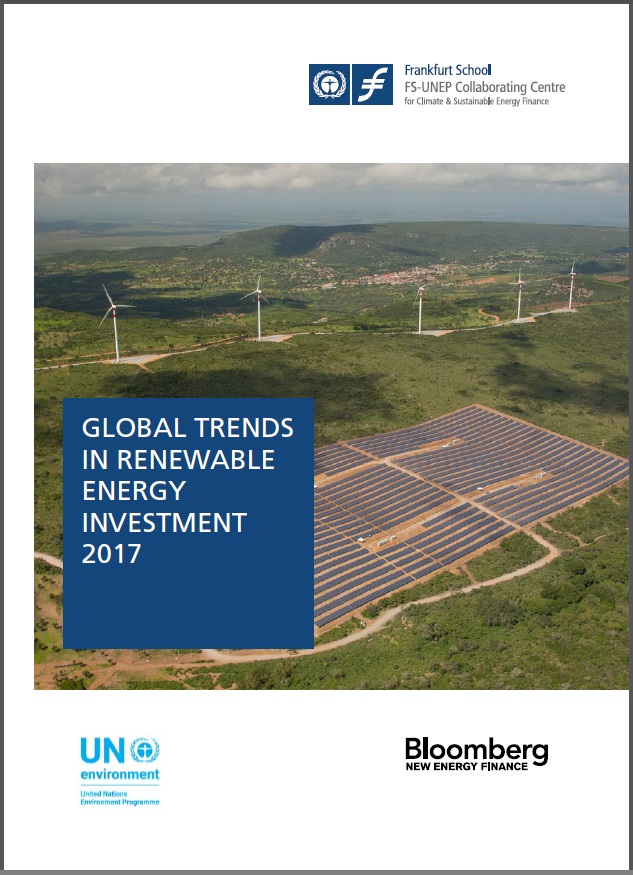Global Trends In Renewable Energy Investment 2017
KEY FINDINGS
•• “More for less” was the story of renewable energy in 2016. Global new investment in renewables excluding large hydro fell by 23% to $241.6 billion, the lowest total since 2013, but there was record installation of renewable power capacity worldwide in 2016. Wind, solar, biomass and waste-to-energy, geothermal, small hydro and marine sources between them added 138.5GW, up from 127.5GW in the previous year.
•• This 2016 gigawatt figure was equivalent to 55% of all the generating capacity added globally, the highest proportion in any year to date. Investment in ‘new renewables’ capacity was roughly double that in fossil fuel generation in 2016, for the fifth successive year. The proportion of global electricity coming from these renewable sources rose from 10.3% in 2015 to 11.3% in 2016, and prevented the emission of an estimated 1.7 gigatonnes of CO2.
•• There were two main reasonsfor the fall in investment in renewables in 2016. One was lower costs, with average dollar capital expenditure per MW down by more than 10% for solar photovoltaics, onshore wind and offshore wind, improving the competitiveness of those technologies. The other was not so positive – there was a marked slowdown in financings in China, Japan and some emerging markets during the course of the year.
•• Overall, renewable energy investment in developing countries fell 30% to $116.6 billion, while that in developed economies dropped 14% to $125 billion. China saw investment plunge 32% to $78.3 billion, breaking an 11-year rising trend. Mexico, Chile, Uruguay, South Africa and Morocco all saw falls in investment of 60% or more, on a mixture of scheduled pauses and delays with auction programmes and financings. Jordan was one of the few new markets to buck the trend, investment there rising 148% to $1.2 billion.
•• Among developed economies, the US saw commitments slip 10% to $46.4 billion, as developers took their time to build out projects to benefit from the five-year extension of the tax credit system. Europe enjoyed a 3% increase to $59.8 billion, led by the UK on $24 billion and Germany on $13.2 billion, down 1% and 14% respectively. Japan slumped 56% to $14.4 billion.
•• Europe’s investment owed its resilience to record commitments to offshore wind, totalling $25.9 billion, up 53% thanks to final investment decisions on mega-arrays such as the 1.2GW Hornsea offshore wind project in the UK North Sea, estimated to cost $5.7 billion. Not all of 2016’s offshore wind boom was in Europe – China invested $4.1 billion in the technology, its highest figure to date.
•• The most hopeful sign last year for the future greening of the global electricity system was a succession of winning bids for solar and wind, in auctions around the world, at tariffs that would have seemed inconceivably low only a few years ago. The records set last year were $29.10 per MWh for solar in Chile and $30 per MWh for onshore wind in Morocco, but there were other eye-catchingly low outcomes to auctions from Dubai to India, and Zambia to Mexico and Peru.
•• Availability of finance does not appear to be a bottleneck to investment in renewables in most countries. Indeed, investor hunger for what many regard as mature technologies helped to fuel record acquisition activity in the clean power sector worldwide last year, totalling $110.3 billion, up 17%. Purchases of assets such as wind farms and solar parks reached a highest-ever figure of $72.7 billion, while corporate takeovers reached $27.6 billion, some 58% more than in 2015.
•• New investment in solarin 2016 totalled $113.7 billion, down 34% from the all-time high in 2015, due in large part to sharp cost reductions – and to real slowdowns in activity in two of the largest markets, China and Japan. India saw the construction of the Ramanathapuram solar complex in Tamil Nadu, billed as the world’s largest ever PV project at some 648MW.
•• Wind followed closely behindsolar, at $112.5 billion of investment globally, down 9% despite the boom in offshore projects. However, while solar capacity additions rose in the year to a record 75GW, sharply up from 56GW, wind capacity additions fell back to 54GW in 2016 from the previous year’s high of 63GW.
•• The smaller sectors of renewable energy had mixed fortunes in terms of investment last year. Biofuels fell 37% to $2.2 billion, the lowest for at least 13 years, biomass and waste held steady at $6.8 billion and small hydro at $3.5 billion, while geothermal rallied 17% to $2.7 billion and marine edged down 7% to $194 million.1
•• One of the up-and-coming innovations in renewable power is the siting of two different technologies in the same location, to make use of shared land, grid connections and maintenance, and to reduce intermittency. Some 5.6GW of these ‘hybrid’ projects have been built or are under development worldwide, including hydro-solar, wind-solar, PV-solar thermal, solar thermal-geothermal and biomass-geothermal. Hybrids are examined in this report’s Focus, Chapter 4, starting on page 44.
To download the full report, please click here.
